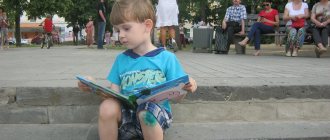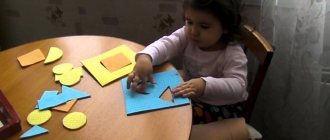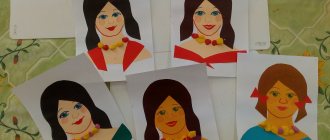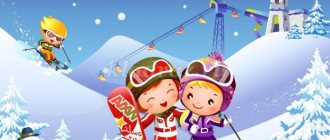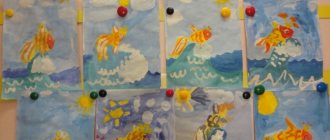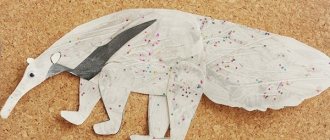Goals and objectives of the teacher in classes on reading fiction
The educator faces important tasks: the upbringing, training and development of children. Fiction is the best assistant in solving problems. Each specific lesson should:
- train attention and memory,
- develop thinking and speech,
- cultivate interest in intellectual pursuits.
In addition, all the works of art studied are focused on different aspects of a child’s life. The most important for children of the preparatory group are:
- moral education,
- speech development,
- artistic and aesthetic development,
- social and communicative development,
- development of independence, self-service.
For example, the fairy tale “Little Khavroshechka” belongs to the field of moral education. The specific goal of the lesson may sound like this: “Cultivate a kind attitude towards each other.” The Russian folk tale “At the Command of the Pike” refers to the development of independence. By studying it, the educator can set himself the goal of “Explaining the importance of human labor.” Social and communicative development occurs when reading the work of D. N. Mamin-Sibiryak “Medvedko”, the purpose of the lesson on this fairy tale is to introduce the world around us, the planet.
Reading in the pre-school group is given special attention
Reading fiction, discussion, situational conversation - this is how the goals set in the classroom are realized. The teacher does not explain the meaning of the fairy tale immediately after reading it - he gives the children the opportunity to figure it out on their own, helps the children see and understand the problem described, for example, through conversation.
Using a question-and-answer form of communication is the optimal way to develop verbal thinking in preschoolers.
For example, when studying the fairy tale “Geese and Swans”, you can include the following questions in the conversation:
- Who is the story about?
- Where are mother and father going?
- What does a mother ask her daughter to do?
- How did your daughter behave after her parents left for the city?
- What happened to brother?
- Who are geese-swans?
- What decision does the girl make?
- Why didn’t the stove, apple tree and milk river want to help the girl?
- Where did the girl run?
- Who did she see in the hut?
- How did the girl manage to save her brother?
- Why do the stove, apple tree and milk river help the girl on the way back?
- Can it be that the stove, the apple tree and the milk river are talking to a girl?
- Where can we find talking animals and talking objects?
A series of questions for a conversation should be structured logically: first, simple questions (based on content), then clarifying, interpretive ("Why..."), evaluative and creative.
It is important to remember that the lesson has one goal, but several tasks.
The teacher solves the following tasks at each lesson:
- educational,
- educational,
- developing.
For example, when studying the fairy tale “The Scarlet Flower,” the following tasks must be solved. Educational: cultivate a kind attitude towards each other. Educational: introduce literature, develop coherent speech, develop listening comprehension of the text. Developmental: develop speech hearing, melodic-intonation side of speech.
Each lesson should have a unique topic and purpose; there may be a subtopic in addition to the main one. Using the example of the fairy tale “The Frog Princess,” we can determine the goal: “Develop the cognitive activity of children, teach to respect other people’s interests,” the topic “Listening to a fairy tale” and the subtopic “Obedience and self-will in a fairy tale...” (moral education). During the conversation, children should understand what obedience and self-will are, how they are expressed, what follows them, how to behave, etc. By motivating children to understand these issues on their own, the teacher will achieve his goal.
Children in the preparatory group should read not only fiction, but also scientific and educational literature
Reading in the preparatory group should be educational. The teacher, developing cognitive interest, raises a conscious reader who, during his school years, will independently motivate himself and read books with pleasure.
Motivating preschoolers in the classroom
In pedagogy, there are four types of motivation for older preschoolers:
- Gaming. It will help the child shift the focus away from the technical difficulties of the reading process. Didactic games: “Reading fables”, “The word is lost”, “Recognize the hero”.
- Helping an adult. It is based on the desire to communicate with an adult, because he will approve and show interest in joint activities. For example: take images of fairy tale characters and ask the children to help you choose or draw outfits (a sundress for a fox, a shirt for a bear).
- “Teach me.” It is based on the desire of every student to feel smart and capable. For example: if a child knows a fairy tale, tell him that you forgot the sequence of actions or do not understand the actions of the characters. This way he will be more confident in discussing the material being studied.
- "With my own hands." Internal interest in making something as a gift for yourself or for your family. Drawings, crafts, postcards - all this can be done during reading lessons, but children must voice all their actions.
As a motivating start to a lesson in reading fiction, you can use games, illustrations to a work, riddles, or a problem situation. For example, when studying the Russian folk tale “The Fox and the Jug,” the teacher can show children pictures of a fox, a jug, a river, and use elements of theatricalization and games to develop intonation (fox exclamations).
Questions for conversation:
- What is this tale about?
- How did the fox get into the jug?
- How did she talk to the jug at first?
- What words did she say?
- How did the fox start talking later?
- What words did she say?
- How does the fairy tale end?
- What kind of fox is shown in this fairy tale and where can it be seen from?
To expand and enrich the vocabulary, you need to discuss the words: greed, stupidity, kindness.
Games to develop intonation:
- Guess the intonation
- Say it kindly
- Say it angrily.
When studying L. N. Tolstoy’s story “The Bone,” you can also use images of the main characters, plums, elements of theatricalization, and didactic games (“Brew compote”). Issues that need to be discussed with children: honesty, fighting temptation, love for family, ability to confess, tell the truth.
Materials for the introductory stage may be different, it all depends on the interest and imagination of the teacher. For example, when studying the Brothers Grimm fairy tale “Mistress Blizzard,” children will be attracted and motivated by music. When studying the Tatar folk tale “Three Daughters,” you can use riddles (about mother, sisters, squirrel, bee) to introduce the characters and include them in active activities.
- Who is the cutest in the world? Who do children love very much? I will answer the question directly: - Our dearest... (mother).
- Who loves both me and my brother, But loves to dress up more? - Very fashionable girl - My eldest... (sister).
- From branch to branch Jumps, frolics, Agile, agile, And not a bird. (Squirrel).
- Flew over the flowers, Flew over the fields. She buzzed merrily. I picked up some nectar. And she took the prey straight to her house... (bee).
For a lesson on the fairy tale “Puss in Boots” by C. Perrault, the teacher can take a cat toy and introduce it to the children as a guest.
The appearance of such a wonderful guest at the lesson will delight the children
Project in the middle group of the preschool educational institution “Favorite Poems”
- May 30, 2019
Fast remote online competitions
Competition “Project activity of a teacher in a preschool educational institution”
Relevance
In the methodology of speech development, a special place is occupied by work aimed at instilling in children a love of poetry, familiarization with poetic works, and development of the ability to perceive and expressively reproduce poetry.
Memorizing poems is one of the means of mental, moral and aesthetic education of children. In preschool age, it is important to teach children to perceive and evaluate a poetic work, and to cultivate artistic taste. By perceiving poetic images, children receive aesthetic pleasure. Poems affect the child with the power and charm of rhythm and melody; Children are attracted to the world of sounds.
The wonderful poems of Agnia Barto, Korney Chukovsky, Samuil Marshak are of great benefit for preschoolers: memorizing poetic works broadens the child’s horizons, rhyme makes it possible to find inner harmony, memory develops, and the cultural level of the little person is formed. Each verbal work, assimilated by the child’s memory, enriches the vocabulary fund that forms his own speech. Expressive performance develops speech technique: diction, breathing.
The most favorable period for memorizing poems is the age of 4-5 years. It is during this age period that the baby’s memory begins to develop especially quickly. And, if until the age of four we do not set the child the task of memorizing a piece, but simply “read” a number of them - what he remembers, he will remember, then after four years it is necessary to purposefully teach the child to memorize the text by heart. And the more a child learns by heart, the more memory he will develop for further learning.
Project goal: To develop in children and parents the interest and ability to memorize and read poetry expressively.
Project objectives:
1. Teach children to read poetry expressively.
2. To form emotional and figurative perception in children through artistic expression.
3. Provide information to parents about the importance of memorizing and expressively reading poetry as a means of developing attention, memory, expressiveness of speech, developing the child’s self-awareness, and the all-round development of the child.
4. Inspire parents to exchange information and share experiences.
Project participants: Children of the middle group (4-5 years old). The project provides for the active participation of parents, children and educators.
Project typology:
Creative, group, practice-oriented, medium duration (2 months).
Predicted result:
- Development of children’s ability to perceive and expressively reproduce poetry, enrichment of vocabulary, development of speech technique, increase in children’s memory capacity.
- Increasing parental competence on the presented problem.
- Participation of families of pupils in the educational process.
- Developed methodological and didactic support for this section.
- The implementation of the project will help instill in preschoolers a love of poetry, their native language, the development of creative imagination, humor, which is invaluable in the further self-realization, adaptation, and study of our students at school.
Author: Elvira Galievna Berdinskaya, teacher at Municipal Budgetary Educational Institution “Kindergarten No. 29”, the city of Sterlitamak, Republic of Bashkortostan.
Project Favorite Poems
Lesson structure
Each lesson with children must comply with the structure of the Federal State Educational Standard for Education and consist of the following parts:
- Introductory part (creating motivation).
- Creating a problematic situation.
- Main part.
- Activity analysis (after each activity).
- Physical education session (one or more).
- The final part (solving a problem situation).
When working with preschool children, you need to plan the lesson very competently. To make it as productive as possible, it is necessary to alternate different types of activities. In addition to reading fiction, you can use play, movement or communication activities.
You can not only read your favorite fairy tale, but also play it
For example, one of the mandatory elements of each lesson is physical education. It helps children take a break from vigorous activity, prevent fatigue, improve their emotional state, etc.
Forms of physical education sessions:
- general developmental exercises,
- outdoor game,
- didactic game with movements,
- dancing,
- movements while reading a poem.
In classes on reading fiction, the teacher can use any of the above forms, but most often movements while reading a poem are used as physical education.
An example of a physical education lesson for reading a poem
In addition, you need to draw up a time plan for the lesson. The teacher must remember that a lesson that lasts more than thirty minutes is ineffective.
The structure of a reading lesson and time plan for the senior group.
- Introductory part. 1–2 minutes.
- Creating a problematic situation. 2–3 minutes.
- Main part. 23–25 minutes.
- Final part. 2–3 minutes
Topic index
Card indexes of fiction are compiled according to different criteria. For example, on lexical topics: fruits/vegetables, trees, bread, seasons, mushrooms/berries, birds, domestic/wild animals, land/water, etc.
- D. N. Mamin-Sibiryak “Gray Neck”,
- N. Nosov “Cucumbers”,
- G. B. Oster “A Kitten Named Woof.”
You can also compile a card index on moral and patriotic education: homeland, society, family, friendship, holidays, citizen, etc.
- N. Nosov “Mishkina porridge”,
- D. Gabe “My Family”,
- Ya. Segel “How I was a mother.”
Safety may also be a criterion for combining works: fires, traffic rules, rules of behavior in nature, etc.
- A. Barto “Thunderstorm”,
- O. Smirnov “Steppe Fire”,
- G. Shalaeva “Do not eat unfamiliar berries in the forest.”
Also popular is the card index compiled by E.V. Shcherbakova according to the program “From birth to school”, ed. NOT. Veraxes. Criteria: educational areas.
From the field of moral education:
- Russian folk tale "Kroshechka-Khavroshechka"
- Russian folk tale "The Braggart Hare"
- Russian folk tale "The Frog Princess"
- B. Shergin “Rhymes”,
- Russian folk tale "Sivka-burka"
- Russian folk tale "Finist - the clear falcon"
- V. Dragunsky “Childhood Friend”, “Top Down, Diagonally”,
- S. Mikhalkov “What do you have?”
- Nenets fairy tale "Cuckoo"
- “Goldilocks” (translated from Czech by K. Paustovsky),
- K. Chukovsky “Moidodyr”.
K. Chukovsky’s book “Moidodyr” must be studied at preschool educational institutions
Table: lesson notes by K. V. Tovmasyan on the topic “Honesty in L. N. Tolstoy’s fairy tale “The Bone””
| GCD stage | Contents of the stage |
| Goal and tasks | Develop an idea of honesty.
|
| Equipment |
|
| Introductory part | Greetings and getting ready to work. - Good afternoon, good hour! I'm so glad to see you. They looked at each other and quietly everyone sat down. – How are you feeling? Game “Find the Bone” – Look at these pictures. Berries are shown here. Find a berry with a seed among them. Getting to know the portrait of the writer. - Look at this portrait. It depicts Lev Nikolaevich Tolstoy. This is a great Russian writer who gave us a lot of interesting stories, fairy tales, poems and even riddles. He loved children very much: he opened a school in Yasnaya Polyana (an estate in the Tula province), taught them according to the “ABC”, which he wrote himself. – Today we will discuss the story of L.N. Tolstoy's "Bone". Want to know what it's about and why it's called that? |
| Main part | The teacher reads the story. Questions for conversation: - What did mom buy? - How did Vanya behave? - Who noticed that the plum was gone? — Why did Vanya decide to eat a plum? - Why didn’t he confess? - Why was dad worried? - What should Vanya have done? Physical education lesson The teacher reads a poem to the children and gives instructions on movements:
— They say: “Everything secret becomes clear sooner and later.” Do you agree with this? Give an example from the story “Bone”. - Tell me, is it necessary to hide something and be dishonest if the truth is found out anyway? Vocabulary work. — In the story there was an expression “blushed like a lobster.” Look at the illustrations for the fairy tale. Do you understand what it means? How else could you describe it? - What does the word “considered” mean? What is the upper room? |
| Final part | - What is the name of the story that we discussed today? - Why is it called that? - What would you do if you were Vanya? - You all worked very well today, well done. |
The teacher’s high-quality work in planning and during fiction reading classes is the key to the productive work of every child. Poems, riddles, didactic games - all this is necessary in the lesson, regardless of the chosen work. Classes in the preparatory group should be positive and exciting for all children, so tasks should be selected that are interesting and varied. This is the only way to instill in children a love of reading and literature.
Summary of OD in the senior group of kindergarten. Reading poems about spring
Summary of educational activities in the senior group Topic: “Reading poems about spring”
Purpose: To introduce children to poetry, understand and reproduce the imagery of the language of the poem. Educational tasks: To cultivate interest in Russian poetry, to show the melodiousness of the language of the poem.. To cultivate a love for the artistic word. Development tasks: To develop auditory attention when perceiving a poem. Promote the development of creative imagination and the beginning of logical thinking. Enrich and activate vocabulary using words: sky, azure, blinds the eyes, ridge, bare trees, dilapidated, invisible, healthy; notice expressive means. Learning objectives: Continue to introduce children to works about spring;
To develop motivational and communication skills, the ability to correctly formulate and prove (if necessary) the correctness of one’s beliefs. To develop basic skills in analyzing a work (its content). To promote the development of the ability to express in speech your feelings that arise when listening to poems about spring. Summary of educational activities
-Guys, listen, what are these sounds?
(sounds of birds singing, rain, murmur of a stream). -What time of year can these sounds be attributed to? (spring) -Why do you Nadya (Liza, Maxim, etc.) think so? -Because there are drops in the spring. -Guys, Vera asked me a riddle, please help me solve it. -I open the buds into green leaves. I dress the trees, I water the crops, There is a lot of movement, they call me... (spring) - by what signs did you guess that it was spring? -Thanks for the tip, I agree with you! - What do you think we will talk about today? - Guys, let's remember what changes occur in nature in the spring? The sun is rising higher and higher. Streams are running. Snow is melting. The buds are swelling. Birds are returning from warm countries. A bear wakes up after hibernation. -Let's think about what objects and phenomena can spring be compared with? Children's answers (with droplets from icicles, with bright sun rays, with snowdrops blooming, with the murmuring of brooks, with the arrival of birds) -What a great fellow you are. Spring is a time of year that everyone loves. Creative people try to reflect their feelings and emotions in their works. -What do composers do? Composing music. -And the artists? They paint pictures. -And the poets? They write poetry. -What other word can you call poetry? Poetry. -I recently read a wonderful poem about spring, would you like me to read it to you? “Spring, spring! how clean the air is!..." Evgeniy Baratynsky Spring, spring! how clean the air is! How clear is the sky! He blinds my eyes with his living azure. Spring, spring! how high on the wings of the breeze, caressing the sun's rays, the clouds fly! The streams are noisy! the streams are shining! Roaring, the river carries on the triumphant ridge the ice it raised! The trees are still bare, But in the grove there is an old leaf, As before, under my foot And it is noisy and fragrant. The invisible lark has soared under the sun and in the bright heights sings a cheerful hymn to spring. (pause) - Now, please tell me, what mood were you in? Cheerful, joyful, happy. -What poem is this? Happy, sad, mournful or solemn? Cheerful, joyful. -Tell me guys, what words does the author use to describe the spring sky? Children's answers. I confirm the children’s statements with lines from the poem: (presentation by E. Baratynsky) Spring, spring! how clean the air is! How clear is the sky! -How do you understand this expression of the author: He blinds my eyes with his living azure. A bright light or shine from snow shines into the eyes so much that it hurts to look. It hurts my eyes. -Tell me, guys, what do you think the author compares the spring wind with? With a bird, it's like he has wings. Spring, spring! how high on the wings of the breeze, -What words does the author use to describe the clouds? They swim, caress, reach for the sun. Caressing the sun's rays, Clouds are flying! -What is said about spring streams? The streams are noisy and sparkle. running, murmuring. The streams are noisy! the streams are shining! -What about the river? The river roared and crackled, as if it had won, the ice on it cracked and it carried it away. Roaring, the river carries on the triumphant ridge the ice it raised! -What words does the poet use to describe nature in his poem? That the trees are not yet dressed, the old leaves rustle underfoot. The trees are still bare, But in the grove there is an old leaf, As before, under my foot And it is noisy and fragrant. -What bird is the poem talking about? About the lark. -What does the poet write about him, in what words does he describe him and his actions? It flies high so that it is not visible. -What else does a lark do? Sings a song. -What do you think he’s singing about? About spring. The invisible lark has soared under the sun and in the bright heights sings a cheerful hymn to spring. -How would you say about what happens in the spring? Let's choose the words: (work on the interactive board, development of coherent speech: “Didactic game”) Physical education The sun, the sun is high (We pull our hands up on tiptoe) The sun makes us feel warm (Lightly stroking our faces with our hands). The snow is melting from the rays, (Squat) The stream ran loudly, (Running in a circle). You run after a stream, step over all the puddles, (Walking in a circle). It is difficult or easy to write poetry, to be a poet. -Do you want to become poets, let’s try to find rhymes for the words: The snow is melting....? The drops are ringing... -Well done! How great you are doing! What do you think can be done with poetry? Read, sing, tell. - You can also recite poetry to music. Now listen to two pieces of music (listen to the pieces in turn). Tell me which piece, in your opinion, is more suitable for our poem? (children's answers) - Well done guys, and everyone is right in their own way. Because each person, after listening to a work, sees or hears it in his own way. Everyone has their own opinion. Re-reading of E. Baratynsky’s poem “Spring, spring! how clean the air is!..." - What did we talk about today? -What do you remember most today? - Well done!
We recommend watching:
Summary of an integrated lesson in the senior group on the topic: Spring Summary of an integrated lesson in the senior group in kindergarten on the topic: Spring Summary of the lesson on the topic: Spring in the senior group of kindergarten with a presentation Summary of GCD in a mixed-age group on the topic: Spring
Similar articles:
Summary of a lesson on a spring topic in the senior group. Description of the painting by Savrasov “The Rooks Have Arrived”
Walking in the senior group. Card file with goals for March
Walking in the senior group. Card file with goals for April
Walking in the senior group. Card file with goals for May
